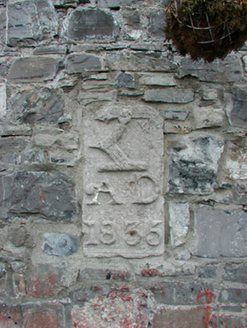Survey Data
Reg No
15306007
Rating
Regional
Categories of Special Interest
Architectural, Artistic, Historical, Social
Original Use
Market place
In Use As
Restaurant
Date
1830 - 1840
Coordinates
265081, 268614
Date Recorded
13/07/2004
Date Updated
--/--/--
Description
Former market place with eight-bay single-storey (with attic level) outbuilding running perpendicular to road, built c.1835, rebuilt c.1990. Now in use as arts centre and café. Pitched natural slate roof with clay ridge tiles. Rubble limestone walls. Segmental-headed openings with brick voussoirs containing modern units to ground floor, loop hole openings above. Cut stone gate piers (on square plan) with cut stone coping and pair of cast-iron gates, flanked by sections of coursed limestone wall surmounted by cast-iron railings to street-frontage (north). Market place enclosed by roughly coursed limestone boundary walls elsewhere. Cut limestone plaque baring dated inscription 'AD 1835' to outbuilding wall.
Appraisal
An attractive market place which forms an important and prominent feature in the centre of Clonmellon. It is unusual in that there never appears to have been a market house here based on cartographic evidence. The building to the east was probably built as an open arcade, which is characteristic of many market houses, suggesting that the building originally preformed much the same function. This structure seems to have been comprehensively rebuilt in recent times but follows the original form and layout. The market square has important historical connections with the Chapman Family of nearby Killua Castle, who originally built the market square in 1835. The heraldic device on the cut stone plaque (an arm holding a broken spear) is from the top of the Chapman Coat of Arms. The cut stone gate pillars, plaque and cast-iron gates are of artistic significance. According to local tradition the gateway was moved from one of the principal entrances to Killua Castle by Sir Montague Chapman in 1845. This could well be the gateway to the north of the Templar gate lodge (15306026). This former civic space is of social importance and it remains an integral component of the architectural heritage of the locality.











